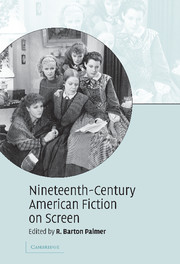Book contents
- Frontmatter
- Contents
- List of illustrations
- Notes on contributors
- Acknowledgments
- Introduction
- 1 A very American fable: the making of a Mohicans adaptation
- 2 Romancing the letter: screening a Hawthorne classic
- 3 The movies in the Rue Morgue: adapting Edgar Allan Poe for the screen
- 4 Readapting Uncle Tom's Cabin
- 5 Screening authorship: Little Women on screen 1933–1994
- 6 Melville's Moby-Dick and Hollywood
- 7 Screening male sentimental power in Ben-Hur
- 8 John Huston's The Red Badge of Courage
- 9 Translating Daisy Miller
- 10 Jane Campion's The Portrait of a Lady
- 11 The Europeans – and the Americans
- 12 Sister Carrie becomes Carrie
- 13 Hollywood and The Sea-Wolf
- 14 An untypical typicality: screening Owen Wister's The Virginian
- Filmography
- Index
- References
9 - Translating Daisy Miller
Published online by Cambridge University Press: 22 December 2009
- Frontmatter
- Contents
- List of illustrations
- Notes on contributors
- Acknowledgments
- Introduction
- 1 A very American fable: the making of a Mohicans adaptation
- 2 Romancing the letter: screening a Hawthorne classic
- 3 The movies in the Rue Morgue: adapting Edgar Allan Poe for the screen
- 4 Readapting Uncle Tom's Cabin
- 5 Screening authorship: Little Women on screen 1933–1994
- 6 Melville's Moby-Dick and Hollywood
- 7 Screening male sentimental power in Ben-Hur
- 8 John Huston's The Red Badge of Courage
- 9 Translating Daisy Miller
- 10 Jane Campion's The Portrait of a Lady
- 11 The Europeans – and the Americans
- 12 Sister Carrie becomes Carrie
- 13 Hollywood and The Sea-Wolf
- 14 An untypical typicality: screening Owen Wister's The Virginian
- Filmography
- Index
- References
Summary
Near the beginning of Henry James's The Portrait of a Lady (1881) we learn that the brother-in-law of Isabel Archer is at a loss to understand her. She is, he observes, “written in a foreign tongue; I can't make her out.” Ludlow goes on to confess, “Well, I don't like originals; I like translations.” The inability of others to take Isabel on her own terms and the need for a familiar context in which she might be placed speak to James's interest in women, especially American women in a European culture where they are often as misunderstood as they might have been in America. But it also speaks to the subject of my essay: the translation of nineteenth-century American originals into the contemporary medium of film. Ludlow would no doubt prefer a two-hour film version of Isabel to the six hundred pages of often dense prose which James (1843–1916) devotes to her. But I also suspect that he might very well be bored if he were to sit through the 126 minutes of Jane Campion's film version of the novel. The point I am making is that the translation of a novel into a film is a much more complicated process than Ludlow might imagine. For my purposes, let me put it another way: translation is not in the service of an audience which cannot decipher an original, but rather, as Walter Benjamin asserts, “Translation marks their stage of a continued life … a transformation and a renewal of something living.”
- Type
- Chapter
- Information
- Nineteenth-Century American Fiction on Screen , pp. 146 - 160Publisher: Cambridge University PressPrint publication year: 2007

